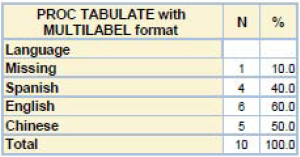- Home
- /
- Programming
- /
- SAS Procedures
- /
- Multiresponse Question
- RSS Feed
- Mark Topic as New
- Mark Topic as Read
- Float this Topic for Current User
- Bookmark
- Subscribe
- Mute
- Printer Friendly Page
- Mark as New
- Bookmark
- Subscribe
- Mute
- RSS Feed
- Permalink
- Report Inappropriate Content
I have a dataset with a series of six variables (coded 0 for no and 1 for yes) related to one question about water use. In the survey, participants were told to select as many responses as were applicable. How can I code this so I see what % of participants chose each response or no responses? I've been able to find the answer for coded data (cards) but not for imported data (from excel).
- Mark as New
- Bookmark
- Subscribe
- Mute
- RSS Feed
- Permalink
- Report Inappropriate Content
Once data has been imported into SAS, the source becomes irrelevant. Just adapt variable names, and you're good.
If you run into problems, post the code you already have, example data and what the result should look like.
- Mark as New
- Bookmark
- Subscribe
- Mute
- RSS Feed
- Permalink
- Report Inappropriate Content
Basically, this is what it looks like in the codebook. As you can see, there are 0 for no and 1 for yes, the variables I want to look at are coded as wat_del_ip through wat_del_or. I want to create a table similar to the one second picture here, but have only been able to find code for data cards and not imported data.

- Mark as New
- Bookmark
- Subscribe
- Mute
- RSS Feed
- Permalink
- Report Inappropriate Content
Here's the codebook picture:

- Mark as New
- Bookmark
- Subscribe
- Mute
- RSS Feed
- Permalink
- Report Inappropriate Content
Since you are working with 0/1 variables, and they are already separate variables, you won't need any examples related to a multilabel format. A simple PROC TABULATE can handle this:
proc tabulate;
var wat_del_ip wat_del_or;
tables wat_del_ip wat_del_or, sum='N' mean*f=percent8.1;
run;
You can change the label for the word 'Mean' is you prefer.
April 27 – 30 | Gaylord Texan | Grapevine, Texas
Registration is open
Walk in ready to learn. Walk out ready to deliver. This is the data and AI conference you can't afford to miss.
Register now and lock in 2025 pricing—just $495!
Learn the difference between classical and Bayesian statistical approaches and see a few PROC examples to perform Bayesian analysis in this video.
Find more tutorials on the SAS Users YouTube channel.
SAS Training: Just a Click Away
Ready to level-up your skills? Choose your own adventure.


